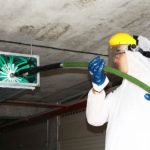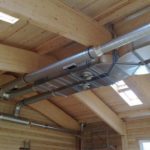Automatic ventilation
The content of the article
Automation of ventilation systems
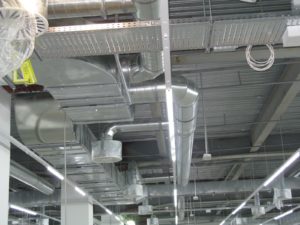 Ventilation in public and industrial buildings is necessary to remove polluted or highly heated air and supply clean air with specified temperature and humidity parameters.
Ventilation in public and industrial buildings is necessary to remove polluted or highly heated air and supply clean air with specified temperature and humidity parameters.
In this case, air exchange and air flow speed are determined according to regulatory requirements depending on the type of premises, technological processes being performed and the intensity of pollution.
The use of automation to control the operation of ventilation allows you to optimize their operation and ensure effective air exchange in premises to create comfortable conditions while people are in them.
Therefore, the presence of automation is of great importance in large and extensive ventilation systems of industrial enterprises, public buildings, sports complexes, train stations, airports and other large structures. A properly selected and adjusted set can ensure the most efficient and uninterrupted air exchange in any room.
Technical tasks performed using automation
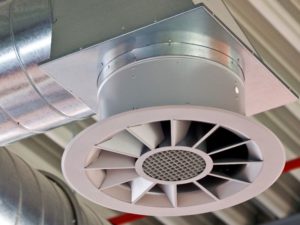 Ventilation automation involves the installation of monitoring, control and executive elements.Their joint work provides control of temperature, humidity, air speed and pressure within the ventilation chamber, in air ducts, on air distribution devices and directly in the premises served.
Ventilation automation involves the installation of monitoring, control and executive elements.Their joint work provides control of temperature, humidity, air speed and pressure within the ventilation chamber, in air ducts, on air distribution devices and directly in the premises served.
Correctly designed, installed and adjusted scheme for automatic control of ventilation of premises or work areas allows you to solve the following problems:
- monitoring control climate indicators and constant monitoring of the performance of main ventilation equipment;
- storing data on operation and parameters of the supplied air for a long time;
- automatic maintenance and change of air supply modes to the serviced premises;
- turning on and off additional ventilation units depending on changes in microclimatic conditions, actual degree of load, time of day and other changing conditions;
- automatic transition to summer or winter operating mode;
- monitoring the level of contamination of air filters, recuperators, air heaters and other equipment;
- ensuring the system shuts down in the event of a short circuit to prevent more serious damage;
- joint work with fire safety systems and shutting off the air supply when a fire is detected;
- possibility of switching to manual operation control.
As additional elements of automated control, a wireless remote control may be provided to make the necessary adjustments to the operation of the ventilation system. Such control can be carried out via the Internet, Wi-Fi or Bluetooth. As a result, controlling the automatic system will become simple and convenient.
Features of industrial ventilation systems
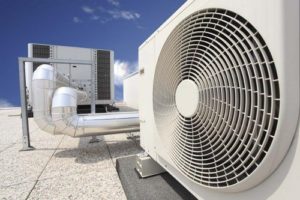 Large branched ventilation systems for industrial workshops are characterized by large volumes of air exchange and the need to distribute air across individual work areas. At the same time, the climatic parameters of individual zones may differ significantly.
Large branched ventilation systems for industrial workshops are characterized by large volumes of air exchange and the need to distribute air across individual work areas. At the same time, the climatic parameters of individual zones may differ significantly.
Therefore, an automatic air distribution system can provide for control of equipment not only in the ventilation chamber, but also on air distribution devices. To do this, sensors must be installed in the serviced work area to monitor air temperature and humidity, and, if necessary, air flow speed.
The organization of regulation can occur by changing the performance of the fan, heater, irrigation chamber and installing actuators on the air distribution grilles.
Requirements for an automation project
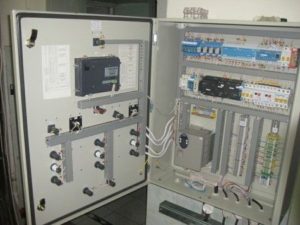 Long-term effective operation of an automated ventilation system can be ensured by developing a project that provides the ability to perform all necessary tasks.
Long-term effective operation of an automated ventilation system can be ensured by developing a project that provides the ability to perform all necessary tasks.
The design of such systems requires certain engineering knowledge and therefore the correct development of the project can only be carried out by a specialist of the appropriate profile who has experience in using equipment from different manufacturers.
All automation devices are divided into three large groups:
- sensors that collect information about the state of the system and air parameters and transmit it for processing;
- controllers and regulators that collect all information from sensors, process it and send signals for execution;
- actuators that ensure the execution of commands coming from regulators.
The main task of the project is to draw up an automation scheme that, when three groups of devices work together, will ensure effective air exchange to create comfortable conditions in the room while people are present.
Installation and commissioning
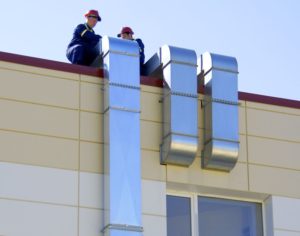 Modern technologies make it possible to create very complex automatic ventilation control systems. Therefore, their installation and subsequent commissioning, even with a well-developed project, must be carried out by professionals. Any installation errors can lead to disruption of air exchange and create conditions where it is impossible for people to stay in the serviced premises.
Modern technologies make it possible to create very complex automatic ventilation control systems. Therefore, their installation and subsequent commissioning, even with a well-developed project, must be carried out by professionals. Any installation errors can lead to disruption of air exchange and create conditions where it is impossible for people to stay in the serviced premises.
An equally important issue will be the commissioning work. At this stage, the quality of ventilation in general is checked and all indicators are brought into compliance with the design specifications.
As a result, proper operation of ventilation will ensure the creation of comfortable microclimatic conditions in rooms or individual areas. The use of modern technology provides significant advantages, ensuring faster execution of necessary commands and freeing up operating personnel. At the same time, the possibility of round-the-clock continuous operation is provided.


